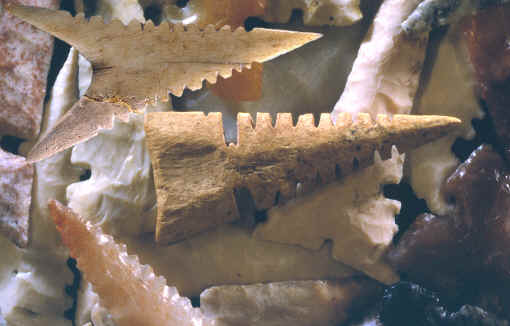|
Most Cahokia bone arrowheads are un-notched triangular
points with straight sides and concave bases. The rarest examples have side
notches. Out of the 16 examples illustrated in this article only four are
side-notched.
|
|

CLICK ON
PICTURE FOR LARGE TRIPLE IMAGE
DOUBLE-NOTCHED BONE POINT
NORTH WINDS SITE
MONROE COUNTY, ILLINOIS
SOUTHERN ILLINOIS
ILLINOIS STATE
COLLECTION
This double notched bone arrow point was found during the excavation
of the North Winds site in Monroe County, Illinois in 2004. It was
found in feature #24 in a trash pit. The North Winds site is an
Emergent Mississippian site belonging to the Dohack Phase.
This bone point has been ground smooth all over.
It does not have any edge serrations that are so often seen on other
bone points from the Cahokia Mounds area. The notches on this point
are also very different from other notched points that are
illustrated in this article. These notches were done with single
cuts at very steep angles. Most side-notched examples have much wider and
deeper notches that were cut perpendicular to the edges. |
|
|
A large
number of bone arrow points from Cahokia have edge serrations, but
serrated points made of stone are rare. Most of the serrated stone arrow
points found at Cahokia were recovered during the
excavation
of Mound 72 where well over 600 finely crafted examples were
discovered in three caches. Only two examples of the 16 bone points
illustrated here are un-serrated. The two un-serrated examples are
represented by both a notched and an un-notched point.
|
|

PHOTO
CREDIT LARRY KINSELLA
BONE POINTS
CAHOKIA MOUNDS SITE
SOUTHERN ILLINOIS
GILCREASE INSTITUTE COLLECTION
These bone points are believed to have been found many years ago on
the Cahokia Mounds site. They represent a style that is most often
seen on bone points from this area. Most of them are serrated with
straight edges and concave bases. The majority of them are also
fairly thin. Only one of the points pictured above represents a different style. It
is un-serrated with a very deep concave base and much thicker than
the other examples. All of these points seem to be representations
of sharks teeth. |
|
|
Cahokia
bone points seem to be effigies of shark teeth, especially the
un-notched examples. They are triangular in outline with serrations on
straight edges and have concave bases. Their design compares very well to the
shape of real sharks teeth. Since several examples of sharks teeth have
been found at Cahokia it's not surprising to see effigies of them in
bone and in some rare cases in stone.
|
|

CLICK ON
PICTURE FOR LARGE IMAGE
DOUBLE-NOTCHED SERRATED BONE POINTS
CAHOKIA MOUNDS SITE
SOUTHERN ILLINOIS
ILLINOIS STATE
MUSEUM COLLECTION
These side-notched serrated bone Cahokia points represents two of the
very best crafted examples for the type. They appear to look more
like the traditional double-notched serrated Cahokia points that are
made of stone. The point on the left is highly polished and measures
1 3/8 inches (3.5 cm) long. |
|
|
In the
central Mississippi Valley, most bone arrow points have been discovered
on Mississippian sites. But the first ones may date to the Late Woodland
period, when arrow points made of stone were first used. Bone points
continued to be used until the early 1800's. No one knows how many arrow
points made of bone were made during the Mississippian period. But we do know that bone was a common
material that would have been readily available. Enough carved, ground and
polished bone arrow points have been found to show that there was a
solid tradition of manufacturing them. It's unfortunate that so few of these
fragile artifacts have survived.
|
|
"REFERENCES"
1912,
Frederick Webb Hodge, "Handbook of American Indians North of
Mexico," p. 159.
1985, Gregory Perino,
"Selected Preforms, Points and Knives of the North American
Indians," p. 40.
1988, Tattersall, Ian, Delson, Eric, Couvering, John Van,
"Encyclopedia of Human Evolution and Prehistory," p.97.
Personal communications with Larry Kincella.
|
|
HOME
ORDERING |



